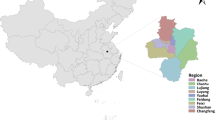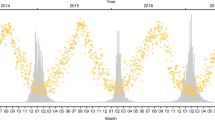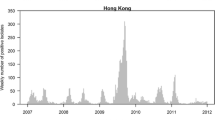Abstract
Until now, we have no thorough understanding the role of absolute humidity on influenza activity, especially in tropical and subtropical areas. In this study, we investigated the relationship between absolute humidity and influenza activity in seven municipalities/provinces covering different climatic zones in China. Weekly meteorological data and influenza surveillance data in seven provinces/municipalities in China were collected from January 2012 to December 2019. A distributed lag nonlinear model was adopted to investigate the association between absolute humidity (AH) and influenza activity in each study site. Then, seven study sites were grouped into three regions: northern, intermediate, and southernmost regions. A multivariate meta-analysis was applied to estimate the exposure-lag-response associations in three regions. The province-specific or municipality-specific curves appeared to be nonlinear, and the association between influenza activity and AH varied across regions. In Beijing and Tianjin, located in northern China, the cumulative relative risks (RRs) increased as weekly average AHmean fell below 3.41 g/m3 and 6.62 g/m3. In Guangdong and Hainan, located in southernmost China, the risk of influenza activity increased with rising average AHmean with 16.74 g/m3 and 20.18 g/m3 as the break points. In Shanghai, Zhejiang, and Chongqing, the relationship between weekly average AHmean and influenza could be described as U-shaped curves, with the lowest RRs when weekly average AHmean was 11.95 g/m3, 11.94 g/m3, and 15.96 g/m3, respectively. Meta-analysis results showed the cumulative RRs significantly increased as weekly average AHmean fell below 3.86 g/m3 in the northern region, whereas significantly increased as weekly average AHmean rose above 18.46 g/m3 and 15.22 g/m3 in intermediate and southernmost regions, respectively. Both low and high AH might increase influenza risk in China, and the relationship varies geographically. Our findings suggest that public health policies for climate change adaptation should be tailored to the local climate conditions.






Similar content being viewed by others
Availability of data and materials
The dataset analyzed is available from the corresponding authors for reasonable requests.
References
Bai Y-L, Huang D-S, Liu J, Li D-Q, Guan P (2019) Effect of meteorological factors on influenza-like illness from 2012 to 2015 in Huludao, a northeastern city in China. PeerJ 7:e6919
Barreca AI, Shimshack JP (2012) Absolute humidity, temperature, and influenza mortality: 30 years of county-level evidence from the United States. Am J Epidemiol 176:S114–S122
Caini S, Spreeuwenberg P, Donker G, Korevaar J, Paget J (2018) Climatic factors and long-term trends of influenza-like illness rates in The Netherlands, 1970–2016. Environ Res 167:307–313
Charland KML, Buckeridge DL, Sturtevant JL, Melton F, Reis BY, Mandl KD et al (2009) Effect of environmental factors on the spatio-temporal patterns of influenza spread. Epidemiol Infect 137:1377–1387
Chen R, Yin P, Wang L, Liu C, Niu Y, Wang W et al (2018) Association between ambient temperature and mortality risk and burden_time series study in 272 main Chinese cities.pdf. BMJ. 363:k4306
Chong KC, Lee TC, Bialasiewicz S, Chen J, Smith DW, Choy WSC et al (2020a) Association between meteorological variations and activities of influenza A and B across different climate zones: a multi-region modelling analysis across the globe. J Infect 80:84–98
Chong KC, Liang J, Jia KM, Kobayashi N, Wang MH, Wei L et al (2020b) Latitudes mediate the association between influenza activity and meteorological factors: a nationwide modelling analysis in 45 Japanese prefectures from 2000 to 2018. Science of The Total Environment 703:134727
Colijn C, Soebiyanto RP, Clara W, Jara J, Castillo L, Sorto OR et al (2014) The role of temperature and humidity on seasonal influenza in tropical areas: Guatemala, El Salvador and Panama, 2008–2013. Plos One 9:e100659
Dai Q, Ma W, Huang H, Xu K, Qi X, Yu H et al (2018) The effect of ambient temperature on the activity of influenza and influenza like illness in Jiangsu Province. China Science of the Total Environment 645:684–691
Davis RE, Dougherty E, McArthur C, Huang QS, Baker MG (2016) Cold, dry air is associated with influenza and pneumonia mortality in Auckland, New Zealand. Influenza Other Respir Viruses 10:310–313
Descalzo MA, Clara W, Guzmán G, Mena R, Armero J, Lara B et al (2016) Estimating the burden of influenza-associated hospitalizations and deaths in Central America. Influenza Other Respir Viruses 10:340–345
Deyle ER, Maher MC, Hernandez RD, Basu S, Sugihara G (2016) Global environmental drivers of influenza. Proc Natl Acad Sci 113:13081–13086
Emukule GO, Mott JA, Spreeuwenberg P, Viboud C, Commanday A, Muthoka P et al (2016) Influenza activity in Kenya, 2007–2013: timing, association with climatic factors, and implications for vaccination campaigns. Influenza Other Respir Viruses 10:375–385
Feng L, Feng S, Chen T, Yang J, Lau YC, Peng Z et al (2019) Burden of influenza-associated outpatient influenza-like illness consultations in China, 2006–2015: a population-based study. Influenza Other Respir Viruses 14:162–172
Ferguson NM, Shaman J, Pitzer VE, Viboud C, Grenfell BT, Lipsitch M (2010) Absolute humidity and the seasonal onset of influenza in the continental United States. PLoS Biology 8:e1000316
Fuhrmann C (2010) The effects of weather and climate on the seasonality of influenza: what we know and what we need to know. Geogr Compass 4:718–730
Gasparrini A, Armstrong B (2013) Reducing and meta-analysing estimates from distributed lag non-linear models.pdf. BMC Medical Research Methodology 13:1
Gasparrini A, Armstrong B, Kenward MG (2010) Distributed lag non-linear models. Stat Med 29:2224–2234
Gasparrini A, Armstrong B, Kenward MG (2012) Multivariate meta-analysis for non-linear and other multi-parameter associations. Stat Med 31:3821–3839
Guo Q, Dong Z, Zeng W, Ma W, Zhao D, Sun X et al (2018) The effects of meteorological factors on influenza among children in Guangzhou. China Influenza and Other Respiratory Viruses 13:166–175
Iuliano AD, Roguski KM, Chang HH, Muscatello DJ, Palekar R, Tempia S et al (2018) Estimates of global seasonal influenza-associated respiratory mortality: a modelling study. The Lancet 391:1285–1300
Katz M, Palekar RS, Rolfes MA, Arriola CS, Acosta BO, Guidos PA et al (2019) Burden of influenza-associated respiratory hospitalizations in the Americas, 2010–2015. Plos One 14:e0221479
Koep TH, Enders FT, Pierret C, Ekker SC, Krageschmidt D, Neff KL et al (2013) Predictors of indoor absolute humidity and estimated effects on influenza virus survival in grade schools. BMC Infectious Diseases 13:71
Lowen AC, Steel J, Schultz-Cherry S (2014) Roles of humidity and temperature in shaping influenza seasonality. J Virol 88:7692–7695
Mahamat A, Dussart P, Bouix A, Carvalho L, Eltges F, Matheus S et al (2013) Climatic drivers of seasonal influenza epidemics in French Guiana, 2006–2010. J Infect 67:141–147
Pascual M, Shaman J, Kandula S, Yang W, Karspeck A (2017) The use of ambient humidity conditions to improve influenza forecast. PLOS Computational Biology 13:e1005844
Peci A, Winter A-L, Li Y, Gnaneshan S, Liu J, Mubareka S et al (2019) Effects of absolute humidity, relative humidity, temperature, and wind speed on influenza activity in Toronto, Ontario, Canada. Applied and Environmental Microbiology 85:e02426–18
Qi L, Gao Y, Yang J, Ding X-B, Xiong Y, Su K et al (2020a) The burden of influenza and pneumonia mortality attributable to absolute humidity among elderly people in Chongqing China, 2012–2018. Science of The Total Environment 716:136682
Qi L, Li Q, Ding X-B, Gao Y, Ling H, Liu T et al (2020b) Mortality burden from seasonal influenza in Chongqing, China, 2012–2018. Hum Vaccin Immunother 16:1668–1674
Qi L, Liu T, Gao Y, Tian D, Tang W, Li Q et al (2021) Effect of meteorological factors on the activity of influenza in Chongqing, China, 2012–2019. Plos One 16:e0246023
Qi L, Xiong Y, Xiao B, Tang W, Ling H, Long J et al (2016) Epidemiological and virological characteristics of influenza in Chongqing, China, 2011–2015. Plos One 11:e0167866
Riley S, Yu H, Alonso WJ, Feng L, Tan Y, Shu Y et al (2013) Characterization of regional influenza seasonality patterns in China and implications for vaccination strategies: spatio-temporal modeling of surveillance data. PLoS Medicine 10:e1001552
Shaman J, Kohn M (2009) Absolute humidity modulates influenza survival, transmission, and seasonality. Proc Natl Acad Sci 106:3243–3248
Shaman J, Soebiyanto RP, Gross D, Jorgensen P, Buda S, Bromberg M et al (2015) Associations between meteorological parameters and influenza activity in Berlin (Germany), Ljubljana (Slovenia), Castile and León (Spain) and Israeli districts. Plos One 10:e0134701
Shoji M, Katayama K, Sano K (2011) Absolute humidity as a deterministic factor affecting seasonal influenza epidemics in Japan. Tohoku J Exp Med 224:251–256
Su W, Liu T, Geng X, Yang G (2020) Seasonal pattern of influenza and the association with meteorological factors based on wavelet analysis in Jinan City, Eastern China, 2013–2016. PeerJ 8:e8626
Tamerius J, Nelson MI, Zhou SZ, Viboud C, Miller MA, Alonso WJ (2011) Global influenza seasonality: reconciling patterns across temperate and tropical regions. Environ Health Perspect 119:439–445
Tamerius JD, Shaman J, Alonso WJ, Bloom-Feshbach K, Uejio CK, Comrie A et al (2013) Environmental predictors of seasonal influenza epidemics across temperate and tropical climates. PLOS Pathogens 9:e1003194
Thai PQ, Choisy M, Duong TN, Thiem VD, Yen NT, Hien NT et al (2015) Seasonality of absolute humidity explains seasonality of influenza-like illness in Vietnam. Epidemics 13:65–73
Xie X, Li Y, Chwang ATY, Ho PL, Seto WH (2007) How far droplets can move in indoor environments. Indoor Air 17:15
Yang J, Zhou M, Ren Z, Li M, Wang B, Liu DL et al (2021) Projecting heat-related excess mortality under climate change scenarios in China. Nat Commun 12:1039
Zhang Y, Ye C, Yu J, Zhu W, Wang Y, Li Z et al (2020) The complex associations of climate variability with seasonal influenza A and B virus transmission in subtropical Shanghai. China. Science of The Total Environment 701:134607
Acknowledgements
We appreciate the China Meteorological Administration and Chinese Center for Disease Control and Prevention for providing meteorological data and influenza surveillance data, and would like to thank all study participants, discussion facilitators, and consultants who contributed to this study.
Funding
Dr. Li Qi was supported by the High-level Medical Reserved Personnel Training Project of Chongqing, Chongqing Health Commission Program (grant number 2019GDRC014), Chongqing Science and Technology Bureau Program (grant number CSTC2021 jscx-gksb-N0005) and China Postdoctoral Science Foundation (grant number 2019M660754). Dr. Jun Yang was supported by the National Natural Science Foundation of China (No. 82003552), and the Guangdong Basic and Applied Basic Research Foundation (No. 2020A1515011161). Dr. Qiyong Liu was supported by the Project commissioned by the Ministry of Ecology and Environment of the People’s Republic of China (No. 202046), the China Prosperity Strategic Programme Fund (SPF) 2015–16 (Project Code: 15LCI1), and the UK-China Cooperation on Climate Change Risk Assessment (PF3051_CH-WS3HBUE_YR1).
Author information
Authors and Affiliations
Contributions
Writing—original draft, methodology, formal analysis, funding acquisition: Li Qi. Writing—original draft, methodology, formal analysis: Tian Liu and Yuan Gao. Resources, conceptualization, supervision, project administration: Qiyong Liu. Resources, conceptualization, supervision: Luzhao Feng. Methodology, software, writing—review and editing, supervision: Jun Yang. Investigation, data curation: Qin Li, Wenge Tang, Kun Su, Yu Xiong, Dechao Tian.
Corresponding authors
Ethics declarations
Ethics statement
Not applicable.
Consent for publication
This study has not been published previously or under consideration for publication elsewhere.
Competing interests
The authors declare no competing interests.
Additional information
Responsible Editor: Lotfi Aleya
Publisher's Note
Springer Nature remains neutral with regard to jurisdictional claims in published maps and institutional affiliations.
Supplementary Information
Below is the link to the electronic supplementary material.
Rights and permissions
About this article
Cite this article
Qi, L., Liu, T., Gao, Y. et al. Effect of absolute humidity on influenza activity across different climate regions in China. Environ Sci Pollut Res 29, 49373–49384 (2022). https://doi.org/10.1007/s11356-022-19279-8
Received:
Accepted:
Published:
Issue Date:
DOI: https://doi.org/10.1007/s11356-022-19279-8




